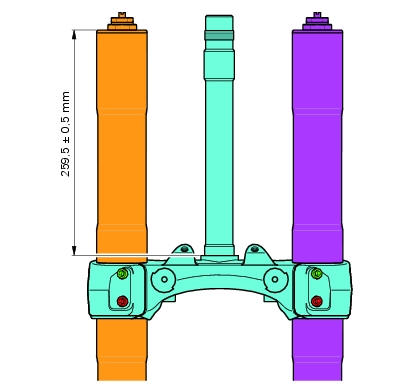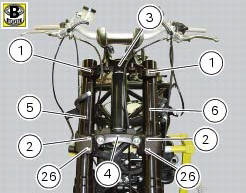
Ducati Diavel Service Manual: Refitting the front forks
Refit the fork legs, positioning them at the height shown in the figure relative to the upper surface of the bottom yoke.

Warning
The difference in height between the two fork legs must be no greater than 0.1 Mm.
Position the fork legs (5) and (6) on the yoke base (4) and on the steering head (3).
Lock the fork legs by tightening the screws (1) to the torque of 20 nm +/- 5%, the screws (2) to the torque of 22 nm +/- 5%, and the screws (26) to 12 nm +/- 5% (sect. 3 - 3, Frame torque settings) that secure the bottom yoke (4) and the steering head (3): tighten one fork leg at a time.
Important
If the screws (1) (2) and (26) were removed on disassembly, smear the threads with the specified grease before tightening.

Refit any parts removed from the frame:

Warning
Do not ride with the front mudguard removed. The brake hoses are retained to the front mudguard to keep them from touching the wheel under braking.
 Overhauling the front forks
Overhauling the front forks
Note
It is advisable to loosen the top cap (14) when the fork is still fitted
to the motorcycle.
Note
The specific tools for the revision of the fork, are described in sect. 3
- 4, Specific too ...
 Steering head: steering
Steering head: steering
Screw
Steering head
Screw
Lower rh u-bolt
Lower lh u-bolt
Bearing
Screw
Sealing ring
Washer
Spacer
Washer
Nut
Washer
Screw
Bottom yoke
Dowel
Nut
Screw
Specia ...
Other materials:
Tft - parameter setting/display
Warning
Any adjustments to the dashboard must only be carried out when the
motorcycle is stationary. Never operate the
dashboard controls while riding the motorcycle.
At the end of the check, the dashboard always displays as the "main"
indication the odometer (tot) on the left and the
averag ...
Reassembly of the timing pulleys
Fit the pulley (11) on the flange (24), aligning the timing mark (d) on the
pulley with the timing mark on the (e) on the
flange.
Install the washer (23) up against the pulley, aligning the timing notch (f)
with the timing marks on the pulley and the
flange.
Insert the three screws (22) ...
Pin code change function
This function changes your four number pin code.
To access the function it is necessary to view the "setting"menu, using buttons
(1) "s" or (2) "t" to select the "pin code"
function and press the reset button (3) to enter the following page.
Note
If "insert new pin code" and the dashes "- - ...